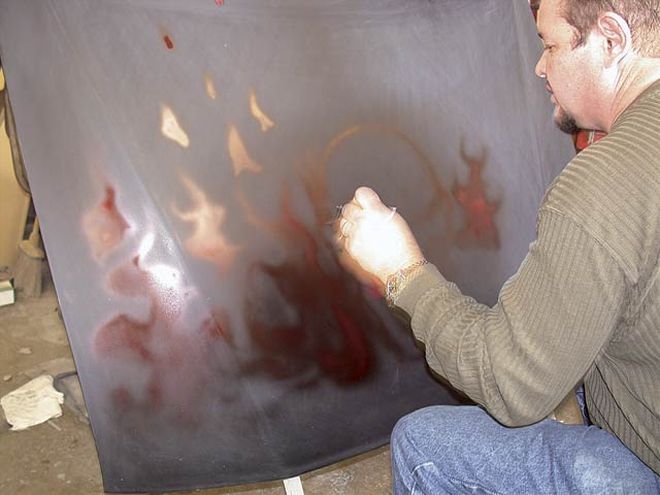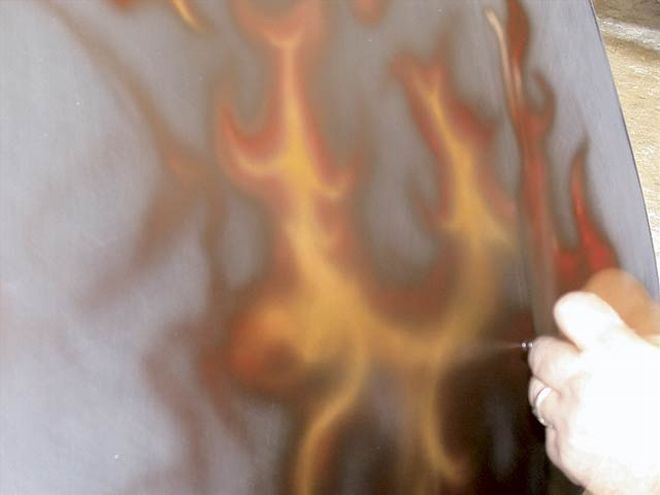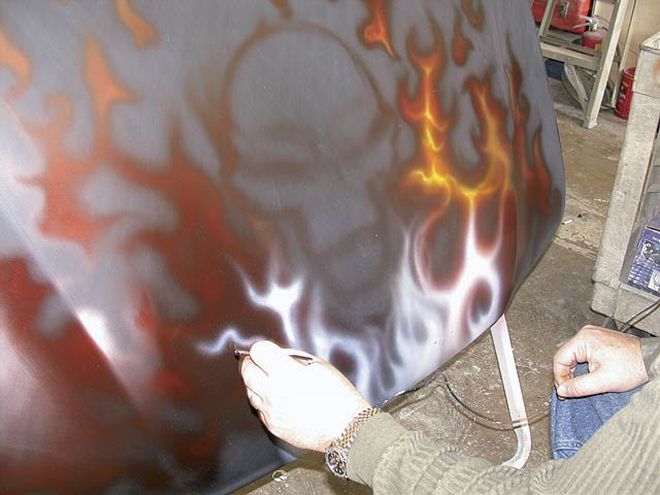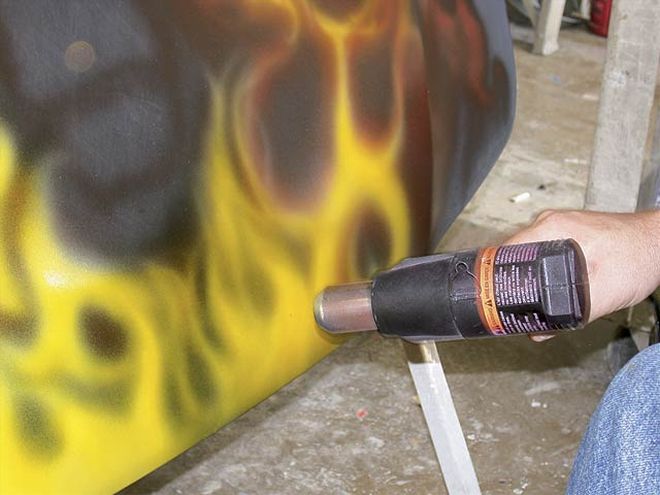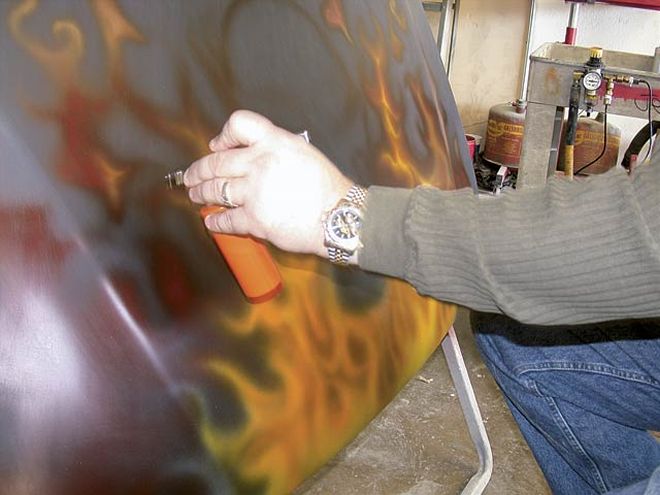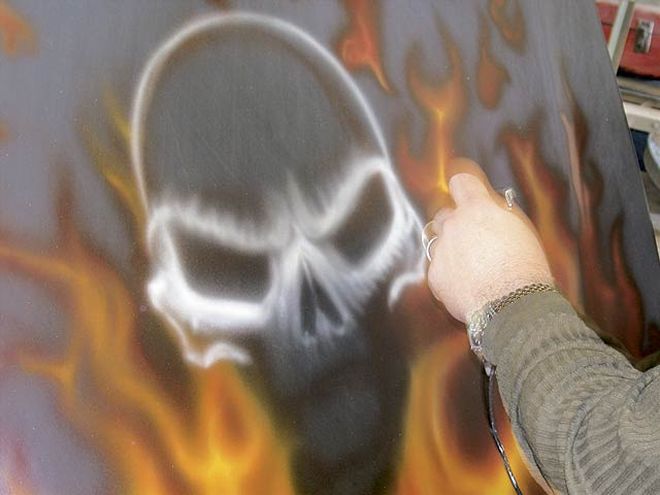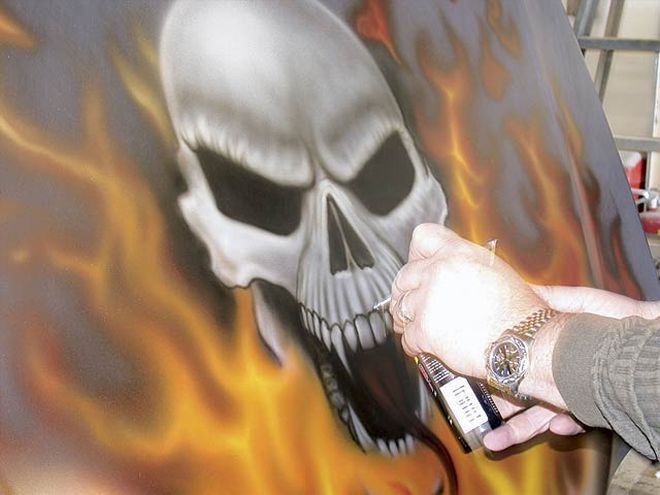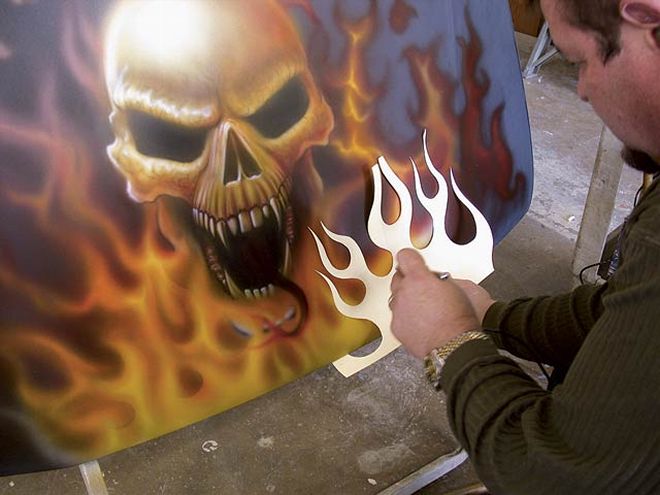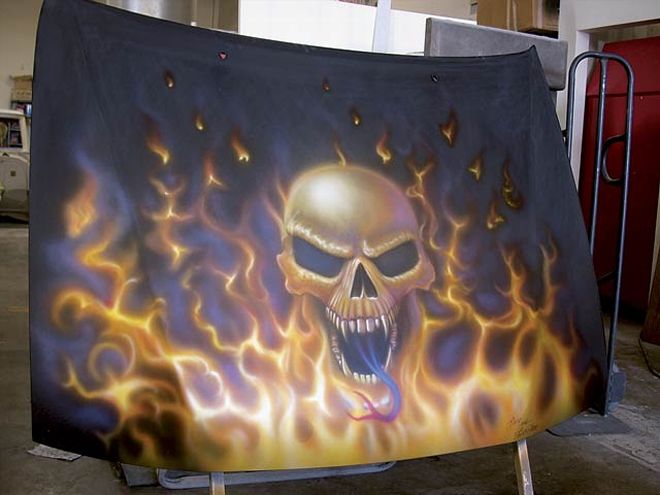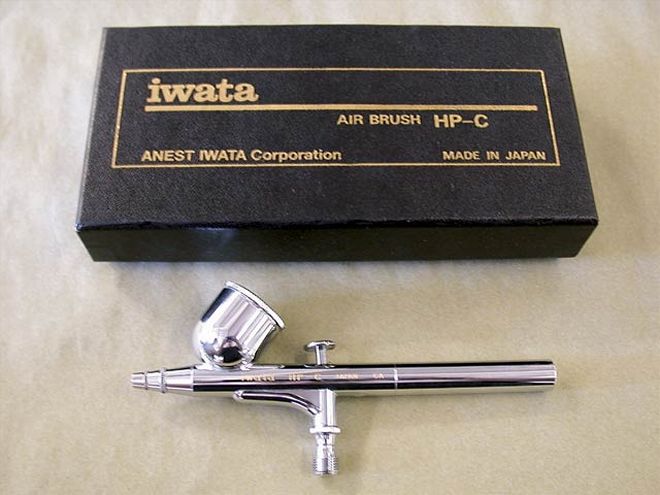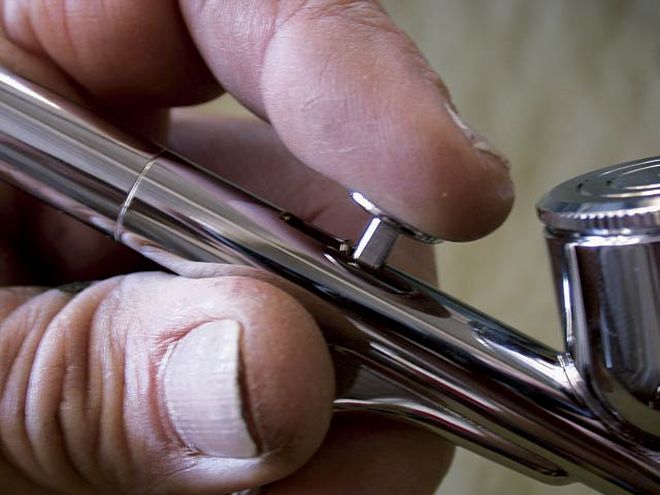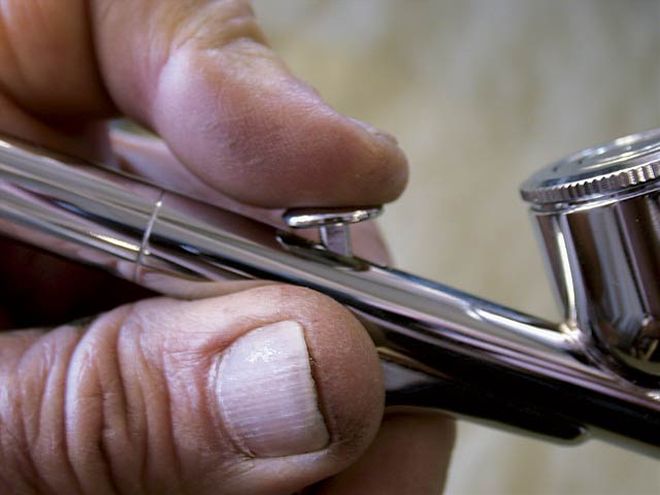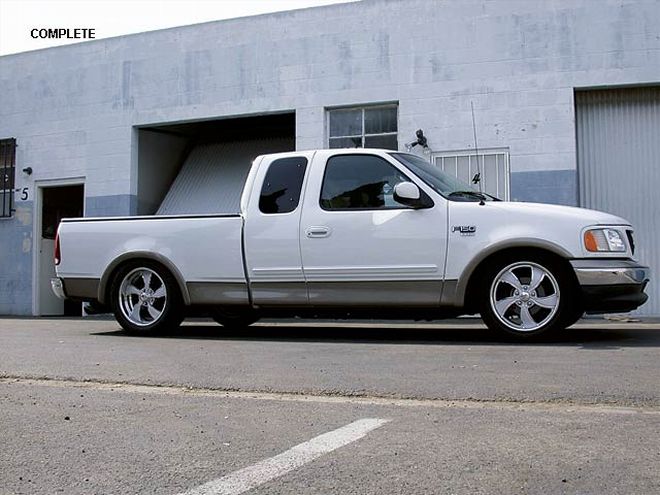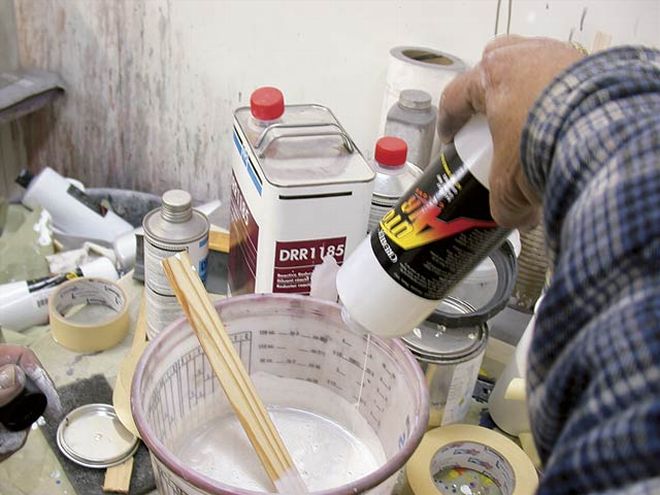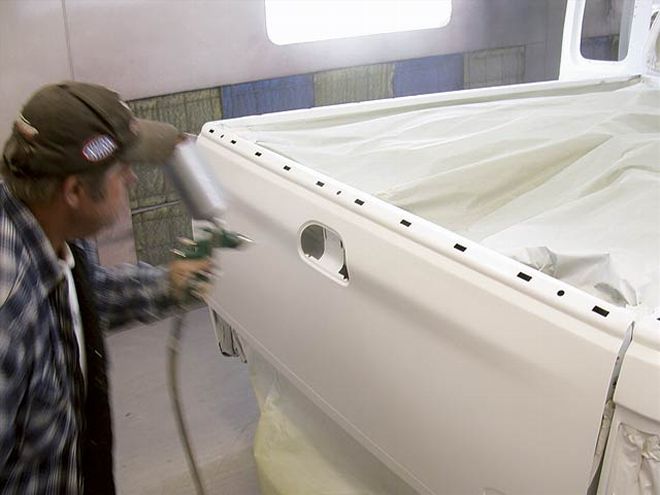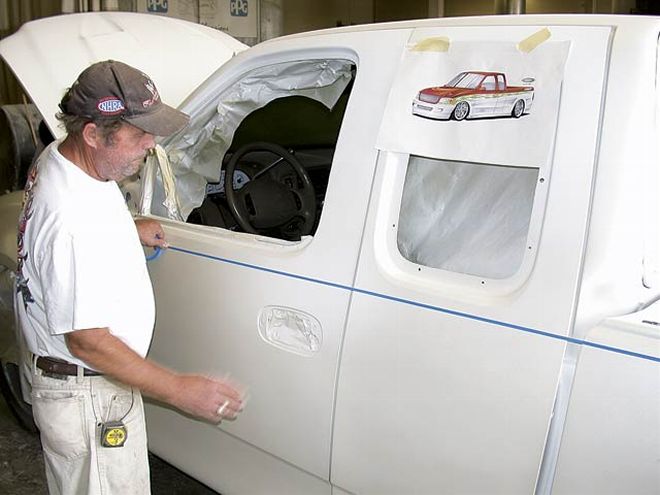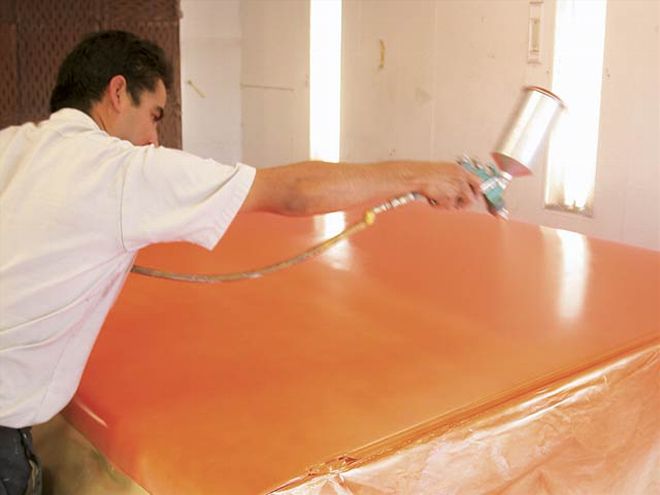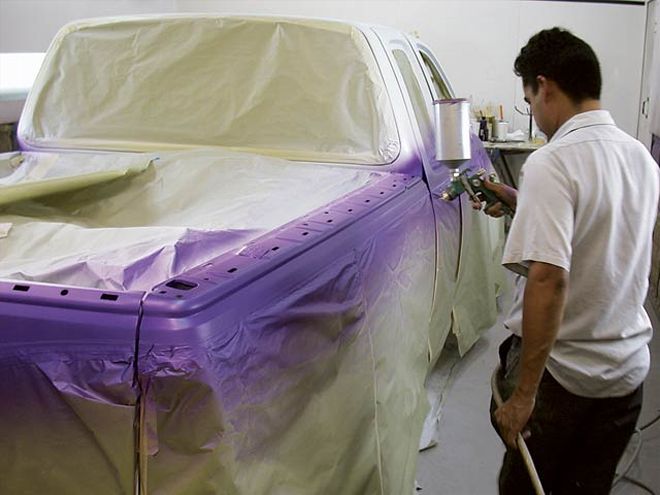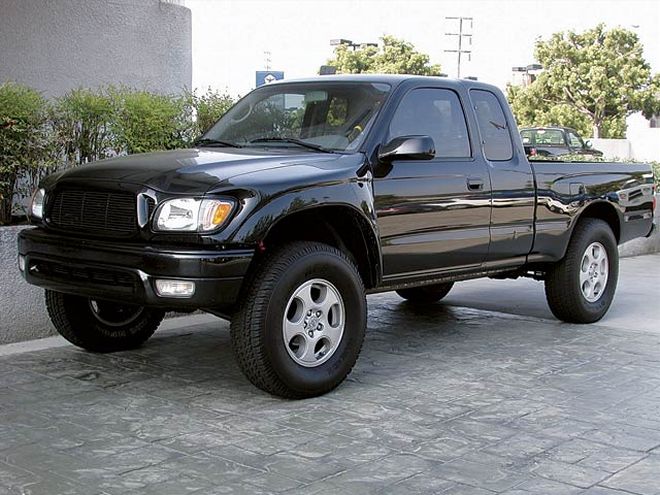
| So here is test truck number one. We will be scuffing the factory finish and applying an airbrushed set of flames on the hood fenders and doors. We chose to just paint these surfaces, because it will keep us from having to clear the entire truck.
Back in our Jan.'04 Issue ("H2O for Your Truck"), we gave you a first-hand look at Auto-Air Color's water-based paints and all the technical information you could swallow. We thought it all sounded great on paper, but like some, we still had a little bit of skepticism that this water stuff could net results like paints of old. We decided to put it to the test in a custom situation and see how it all worked. We duplicated both situations you might get into building a truck, a complete repaint, and the addition of graphics to a factory finish.
Before we get into how it all worked, we should give you a refresher on why anyone should spray it. First off, we are not going to sit here and tell you this stuff is new. As a matter of fact, water-based paints (WBP) have been around since the 1980s. What is new is the quality and performance. Whereas WBP used to be thought of as only coming in OE colors, now you can get candies, flakes, and pearlized colors to feed the need for one-off designs. Some other key features of the Auto-Air Colors WBPs are the lack of VOCs, so you can spray in your garage. The paint self-levels when drying to cut down on orange peel, and water-based binders are extremely clear, allowing for bright and vibrant finishes.
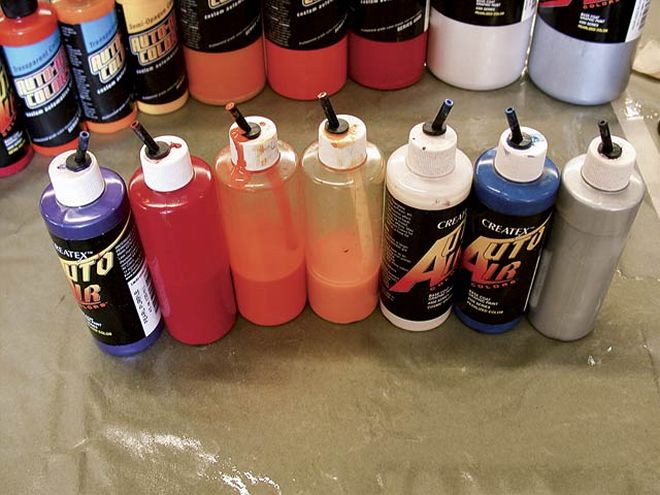
| Here are the colors that Mickey used from Auto-Air's line of paints. Some of them are a pearlized style and some are the company's new Sparklescent colors, which are a candied-pearl blend. These new paints light up well when the sun hits them, and they can be used alone or as a base for candies to produce incredible depth.
One of the best features we noticed during this whole process is the paint's user-friendliness. Since it's water-based, if you're working on a design and it's not working like you would hope, it can be wiped off with just a wet rag, and it makes for easy gun clean-up. To sum it all up, water-based basecoats offer many performance advantages: compatibility with most any urethane, virtually no time windows, a non-flammable composition , an easy clean up, and no VOC concerns.
At this time, none of us here at the mag are in any way professional painters. Don't get us wrong - we're spending as much time as we can at our shops, sniffing the fumes and learning on the fly. So to bring you the best story we could, we hooked up with a few very talented professionals to spray our trucks.
We hooked up with Jerry Sievers from Paint N Place near our offices in Anaheim, California, to use his skills and his shop. You have already seen the outcome of the Ford truck within this story that Jerry did the complete repaint on for 2003's SEMA.
The other gentleman you will see in here is Mickey Harris, who has been painting for 35 years, starting at the age of 19, and has produced thousands of murals on metal. Mickey was the president of the International Airbrush Association and has won the DuPont Top Gun award four times.
All right, enough with the meet-and-greet, let's get to the paint.
Dual Action
Mickey recommends that if you want to do any of this style of work, make sure to find a dual-action brush. Much like the bigger spray guns, these have a trigger that has the air and the fluid on different channels. Push down for air and then rock it back for fluid.
 | So here is test truck number one. We will be scuffing the factory finish and applying an airbrushed set of flames on the hood fenders and doors. We chose to just paint these surfaces, because it will keep us from having to clear the entire truck.
Back in our Jan.'04 Issue ("H2O for Your Truck"), we gave you a first-hand look at Auto-Air Color's water-based paints and all the technical information you could swallow. We thought it all sounded great on paper, but like some, we still had a little bit of skepticism that this water stuff could net results like paints of old. We decided to put it to the test in a custom situation and see how it all worked. We duplicated both situations you might get into building a truck, a complete repaint, and the addition of graphics to a factory finish.
Before we get into how it all worked, we should give you a refresher on why anyone should spray it. First off, we are not going to sit here and tell you this stuff is new. As a matter of fact, water-based paints (WBP) have been around since the 1980s. What is new is the quality and performance. Whereas WBP used to be thought of as only coming in OE colors, now you can get candies, flakes, and pearlized colors to feed the need for one-off designs. Some other key features of the Auto-Air Colors WBPs are the lack of VOCs, so you can spray in your garage. The paint self-levels when drying to cut down on orange peel, and water-based binders are extremely clear, allowing for bright and vibrant finishes.
| So here is test truck number one. We will be scuffing the factory finish and applying an airbrushed set of flames on the hood fenders and doors. We chose to just paint these surfaces, because it will keep us from having to clear the entire truck.
Back in our Jan.'04 Issue ("H2O for Your Truck"), we gave you a first-hand look at Auto-Air Color's water-based paints and all the technical information you could swallow. We thought it all sounded great on paper, but like some, we still had a little bit of skepticism that this water stuff could net results like paints of old. We decided to put it to the test in a custom situation and see how it all worked. We duplicated both situations you might get into building a truck, a complete repaint, and the addition of graphics to a factory finish.
Before we get into how it all worked, we should give you a refresher on why anyone should spray it. First off, we are not going to sit here and tell you this stuff is new. As a matter of fact, water-based paints (WBP) have been around since the 1980s. What is new is the quality and performance. Whereas WBP used to be thought of as only coming in OE colors, now you can get candies, flakes, and pearlized colors to feed the need for one-off designs. Some other key features of the Auto-Air Colors WBPs are the lack of VOCs, so you can spray in your garage. The paint self-levels when drying to cut down on orange peel, and water-based binders are extremely clear, allowing for bright and vibrant finishes.
 | Here are the colors that Mickey used from Auto-Air's line of paints. Some of them are a pearlized style and some are the company's new Sparklescent colors, which are a candied-pearl blend. These new paints light up well when the sun hits them, and they can be used alone or as a base for candies to produce incredible depth.
One of the best features we noticed during this whole process is the paint's user-friendliness. Since it's water-based, if you're working on a design and it's not working like you would hope, it can be wiped off with just a wet rag, and it makes for easy gun clean-up. To sum it all up, water-based basecoats offer many performance advantages: compatibility with most any urethane, virtually no time windows, a non-flammable composition , an easy clean up, and no VOC concerns.
At this time, none of us here at the mag are in any way professional painters. Don't get us wrong - we're spending as much time as we can at our shops, sniffing the fumes and learning on the fly. So to bring you the best story we could, we hooked up with a few very talented professionals to spray our trucks.
We hooked up with Jerry Sievers from Paint N Place near our offices in Anaheim, California, to use his skills and his shop. You have already seen the outcome of the Ford truck within this story that Jerry did the complete repaint on for 2003's SEMA.
The other gentleman you will see in here is Mickey Harris, who has been painting for 35 years, starting at the age of 19, and has produced thousands of murals on metal. Mickey was the president of the International Airbrush Association and has won the DuPont Top Gun award four times.
All right, enough with the meet-and-greet, let's get to the paint.
| Here are the colors that Mickey used from Auto-Air's line of paints. Some of them are a pearlized style and some are the company's new Sparklescent colors, which are a candied-pearl blend. These new paints light up well when the sun hits them, and they can be used alone or as a base for candies to produce incredible depth.
One of the best features we noticed during this whole process is the paint's user-friendliness. Since it's water-based, if you're working on a design and it's not working like you would hope, it can be wiped off with just a wet rag, and it makes for easy gun clean-up. To sum it all up, water-based basecoats offer many performance advantages: compatibility with most any urethane, virtually no time windows, a non-flammable composition , an easy clean up, and no VOC concerns.
At this time, none of us here at the mag are in any way professional painters. Don't get us wrong - we're spending as much time as we can at our shops, sniffing the fumes and learning on the fly. So to bring you the best story we could, we hooked up with a few very talented professionals to spray our trucks.
We hooked up with Jerry Sievers from Paint N Place near our offices in Anaheim, California, to use his skills and his shop. You have already seen the outcome of the Ford truck within this story that Jerry did the complete repaint on for 2003's SEMA.
The other gentleman you will see in here is Mickey Harris, who has been painting for 35 years, starting at the age of 19, and has produced thousands of murals on metal. Mickey was the president of the International Airbrush Association and has won the DuPont Top Gun award four times.
All right, enough with the meet-and-greet, let's get to the paint.
